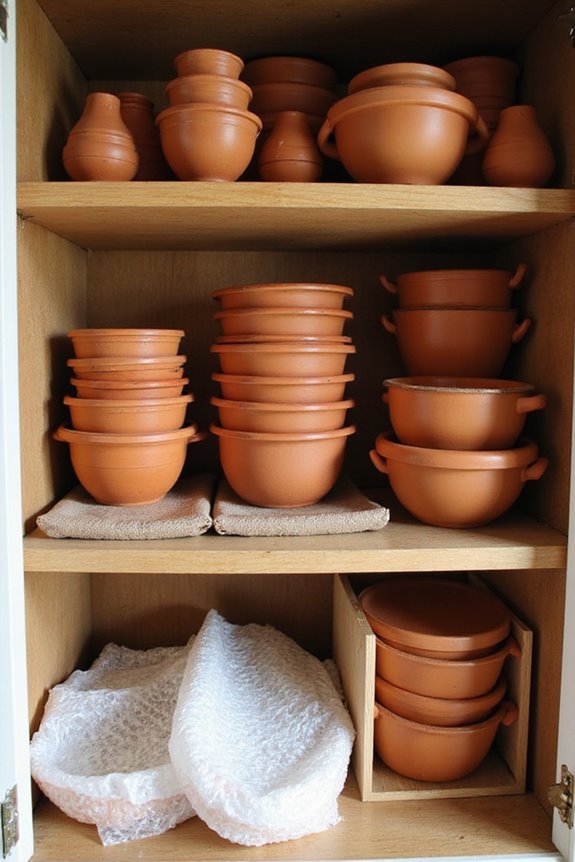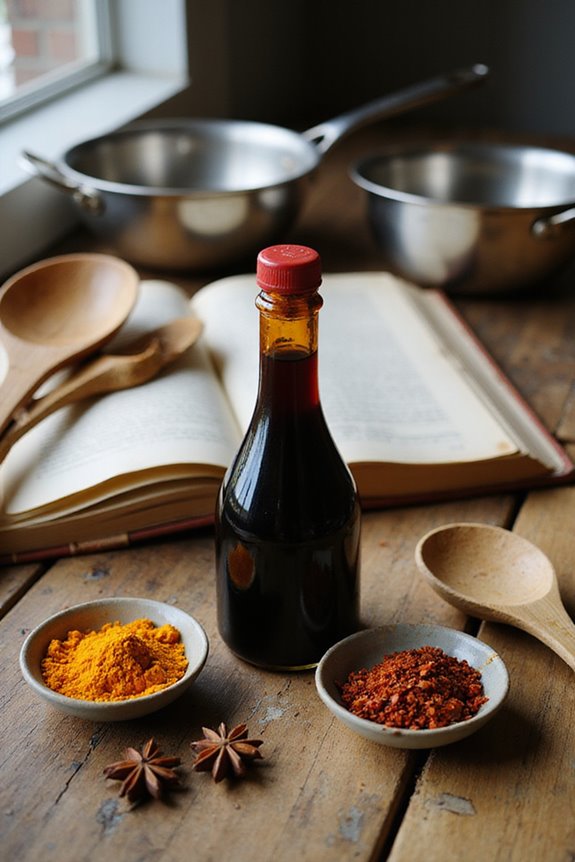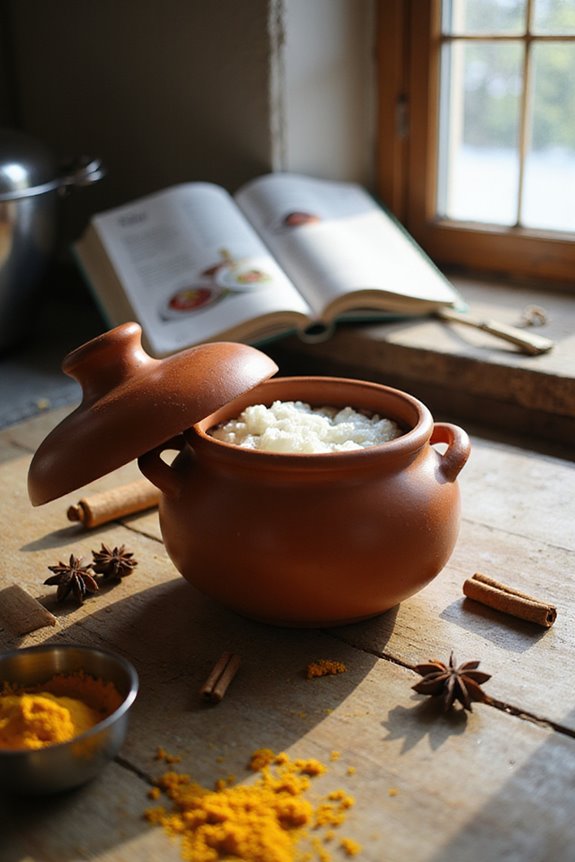To store clay pots effectively, let’s keep things delightful! We should place them in well-ventilated, cozy spots where they can breathe. Avoid damp corners and guarantee moderate humidity; think of it as keeping our festive holiday treats safe! Always handle them with care to prevent breakage, and clean them gently. Remember to keep them dry for long-lasting magic! Stick around, and we’ll uncover more fantastic tips for maintaining our charming clay pots!
Key Takeaways
- Store clay pots in well-ventilated areas to prevent mold and mildew growth.
- Avoid overly damp locations; moderate humidity is ideal for preservation.
- Place pots in a stable environment to protect eco-friendly materials from temperature fluctuations.
- Stack pots with cloth in between to prevent scratches and damage.
- Keep pots clean and dry, avoiding contaminants to enhance longevity.
Understanding Evaporative Cooling in Clay Pots
Have you ever wished for a magical way to keep food fresh without using electric refrigerators? Well, our trusty clay pots utilize evaporative cooling to do just that! When we water the pot, moisture seeps through its porous surface. This evaporation absorbs heat, making the inside cooler, just like how sweating refreshes us on a hot summer’s day.
Here’s how it works:
- Low Thermal Conductivity: Clay acts like an insulator, minimizing heat flow into the water.
- Cool Climate Friend: It works best in low humidity and warm temperatures—perfect for summer picnics!
- Continuous Care: Regular watering keeps the magic alive. Additionally, using high-grade materials can enhance the effectiveness of cooling methods in similar cooking or storage applications.
Choosing the Right Storage Location

Now that we’ve uncovered the enchanting world of evaporative cooling in clay pots, it’s time to think about where we’ll keep these delightful kitchen companions. Choosing the right storage location is essential for their longevity!
- Ventilation Techniques: We should select a well-ventilated area. Good air circulation is vital to prevent mold and mildew.
- Humidity Management: Let’s avoid overly damp spots and prefer moderate humidity levels. Too much moisture can harm our pots!
- Temperature Control: Not too hot or too cold; we want a cozy, stable environment. Utilizing proper storage conditions is necessary to ensure the best eco-friendly materials for our clay pots remain protected from damage.
Proper Handling and Placement

When it comes to keeping our cherished clay pots in tip-top shape, proper handling and placement is a game changer! Here are some delightful tips to guarantee they stay magical:
- Let’s let our pots cool to room temperature before cleaning to avoid thermal shock.
- Handle with care, like we’re dealing with delicate holiday ornaments—no dropping allowed!
- Use soft scrubbers instead of harsh tools. It’s all about loving our pots, right?
- For storage, let’s stack them with cloth in between to prevent scratches and chipping.
- Remember to keep them dry and away from contaminants.
- Additionally, ensuring our pots have proper material quality can help maintain their integrity over time.
With these simple practices, our clay pots will thrive and serve up delicious meals for years to come!
Cleaning Techniques for Clay Pots

Baking Soda Method:
- Mix 4 tablespoons baking soda with 2 tablespoons water to form a paste.
- Generously apply it inside and outside your pot.
- Let it dry for an hour, scrub with a nonmetallic scrubber, and rinse.
Salt Scrub:
- Sprinkle coarse salt inside your pot.
- Use a soft brush to scour away grime.
- Rinse with warm water—voilà, a deodorized pot! Additionally, maintaining proper care is essential to ensure the longevity of your clay pots.
Maintenance of Cooling Efficiency

To keep our charming clay pots working their cooling magic, we need to focus on a few key maintenance strategies that really amp up their efficiency!
- Water Replenishment: Just like we need hydration on a hot day, our pots need regular watering. In drier climates, we might need to water multiple times daily to keep that delightful cooling going.
- Airflow Management: Placing our pots where there’s good airflow is essential. Shady, breezy spots help keep temperatures lower and evaporation higher. Additionally, ensuring that we select appropriate pot size for plants can enhance moisture retention and improve overall plant health.
Best Practices for Food and Produce Storage
Storing food in clay pots isn’t just practical; it can be downright delightful! These magical containers do wonders for moisture regulation, keeping our fruits and veggies fresh. Here’s how to get the most out of our clay pot food storage:
- Food Compatibility: Stick to root veggies like potatoes and onions, avoiding acidic or oily foods.
- Humidity Control: Place pots in cool, dark spots (think spooky Halloween basements!) to maintain ideal temperatures between 50-70°F.
- Separate Storage: Keep fruits and veggies in different pots to prevent early spoilage—no one wants that mushy banana ruining the party! Additionally, using high-grade materials like those found in premium kitchen tools can enhance your overall food storage experience.
Water Storage Advantages and Considerations
When it comes to keeping our water invigoratingly cool and delicious, using clay pots offers some delightful advantages! Here’s why we should consider them for water storage:
- Natural Cooling: Clay’s porous nature leads to evaporative cooling, keeping our water pleasantly chill—perfect for those hot summer picnics!
- Water Quality: The minerals in clay, like calcium and magnesium, not only flavor our drinks but also support our bodies’ nutrient absorption. It’s like giving our water a little health boost!
- Filtration: Clay types effectively filter impurities, making our drinking water cleaner and safer. Who knew hydration could be so magical?
Incorporating these pots into our routine is a simple, eco-friendly way to enhance our hydration game while enjoying a little earth-loving charm!
Recognizing Limitations and Risks
While the charm and benefits of clay pots are simply delightful for water storage, it’s equally important to recognize their limitations and risks.
Fragility Awareness:
– Clay pots are fragile and can easily crack if mishandled. Careful handling is key!
Microbial Risks:
– Their porous nature can trap bacteria if not cleaned properly. Regular cleaning keeps our pots safe!
Storage Tips:
– Store in dry, stable environments. Avoid stacking and heavy items.
Frequently Asked Questions
Can I Store Clay Pots Outdoors Year-Round?
We can’t recommend outdoor storage for clay pots year-round. The weather exposure can lead to cracks and other damage. Let’s explore better options to keep our cherished pots safe and ready for gardening together!
How Do I Prevent Clay Pots From Cracking?
To prevent cracking, we’ve found that managing moisture is essential. Let’s keep our clay pots at consistent moisture levels and avoid extreme temperatures. Together, we can cherish our pots and guarantee they’re well cared for!
Should I Apply Sealant to Clay Pots?
They say, “An ounce of prevention is worth a pound of cure.” When deciding about sealants, we must consider sealant types and application techniques. A well-applied sealant can preserve our clay pots beautifully and effectively.
Can I Use Clay Pots for Other Items Besides Food?
Absolutely, we can use clay pots for decorative uses and craft projects! They’re perfect for organizing tools or creating unique planters, adding a personal touch to our spaces while being environmentally friendly. Let’s get creative together!
How Often Should I Replace My Clay Pots?
Did you know that replacing clay pots every 2 to 5 years is common? By practicing proper clay maintenance, we can maximize pot lifespan and enjoy cooking with them safely for years to come together!





